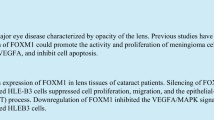Abstract
Purpose
Posterior capsule opacification (PCO) is a common postoperative complication of cataract surgery. Epithelial–mesenchymal transition (EMT) of lens epithelial cells (LECs) is an important initial step of PCO pathogenesis. We have previously shown that Bit1 expresses in rat LECs. In this study, we aim to investigate the role of Bit1 in the EMT of human LECs.
Methods
The expression of Bit1 was firstly detected in human PCO-attached LECs and human lens cell line SRA01/04 by real-time PCR and immunofluorescence staining. The proliferation and migration of Bit1 knockdown SRA01/04 cells were evaluated by cell counting, wound-healing assay, and transwell migration assay. The EMT of LECs was triggered by TGF-β2, and then the effect of Bit1 on EMT with a key biomarker of α-smooth muscle actin (α-SMA) was analyzed by siRNA knockdown assay, and the reversal of EMT was validated by real-time PCR and western blot.
Results
Bit1 was obviously augmented in LECs derived from PCO tissues and Bit1 expressed with high levels in the cytoplasm of cultured SRA01/04 cells. Cell proliferation, invasion, and migration, as well as α-SMA expression, were significantly decreased in Bit1 knockdown SRA01/04 cells. While TGF-β2 elevated Bit1 and α-SMA expression levels in a dose-dependent manner, with peak levels at 10 ng/ml of TGF-β2 treatment, suppression of Bit1 in SRA01/04 cells reversed the EMT process. TGF-β2 induced elevation of α-SMA expression level, as well as migration, and invasion abilities were all suppressed by Bit1 deficiency.
Conclusions
These findings reveal that Bit1 promotes TGF-β2 induced α-SMA expression and acts as an positive regulator of EMT. Suppressing Bit1 inhibits the proliferation, migration, and EMT of LECs. Bit1 may be a potential novel therapeutic target for the prevention and treatment of PCO.




Similar content being viewed by others
References
Awasthi N, Guo S, Wagner BJ (2009) Posterior capsular opacification: a problem reduced but not yet eradicated. Arch Ophthalmol 127:555–562. doi:10.1001/archophthalmol.2009.3
Wormstone IM, Wang L, Liu CS (2009) Posterior capsule opacification. Exp Eye Res 88:257–269. doi:10.1016/j.exer.2008.10.016
Apple DJ, Solomon KD, Tetz MR, Assia EI, Holland EY, Legler UF, Tsai JC, Castaneda VE, Hoggatt JP, Kostick AM (1992) Posterior capsule opacification. Surv Ophthalmol 37:73–116
De Pereda JM, Waas WF, Jan Y, Ruoslahti E, Schimmel P, Pascual J (2004) Crystal structure of a human peptidyl-tRNA hydrolase reveals a new fold and suggests basis for a bifunctional activity. J Biol Chem 279:8111–8115. doi:10.1074/jbc.M311449200
Jan Y, Matter M, Pai JT, Chen YL, Pilch J, Komatsu M, Ong E, Fukuda M, Ruoslahti E (2004) A mitochondrial protein, Bit1, mediates apoptosis regulated by integrins and Groucho/TLE corepressors. Cell 116:751–762
Biliran H, Jan Y, Chen R, Pasquale EB, Ruoslahti E (2008) Protein kinase D is a positive regulator of Bit1 apoptotic function. J Biol Chem 283:28029–28037. doi:10.1074/jbc.M803139200
Griffiths GS, Grundl M, Leychenko A, Reiter S, Young-Robbins SS, Sulzmaier FJ, Caliva MJ, Ramos JW, Matter ML (2011) Bit-1 mediates integrin-dependent cell survival through activation of the NFkappaB pathway. J Biol Chem 286:14713–14723. doi:10.1074/jbc.M111.228387
Ma B, Sen T, Asnaghi L, Valapala M, Yang F, Hose S, McLeod DS, Lu Y, Eberhart C, Zigler JS Jr, Sinha D (2011) betaA3/A1-Crystallin controls anoikis-mediated cell death in astrocytes by modulating PI3K/AKT/mTOR and ERK survival pathways through the PKD/Bit1-signaling axis. Cell Death Dis 2:e217. doi:10.1038/cddis.2011.100
Karmali PP, Brunquell C, Tram H, Ireland SK, Ruoslahti E, Biliran H (2011) Metastasis of tumor cells is enhanced by downregulation of Bit1. PLoS One 6, e23840. doi:10.1371/journal.pone.0023840
Stupack DG, Cheresh DA (2004) A Bit-role for integrins in apoptosis. Nat Cell Biol 6:388–389. doi:10.1038/ncb0504-388
Kairouz-Wahbe R, Biliran H, Luo X, Khor I, Wankell M, Besch-Williford C, Pascual J, Oshima R, Ruoslahti E (2008) Anoikis effector Bit1 negatively regulates Erk activity. Proc Natl Acad Sci U S A 105:1528–1532. doi:10.1073/pnas.0711357105
Gilmore AP (2005) Anoikis. Cell Death Differ 12(Suppl 2):1473–1477. doi:10.1038/sj.cdd.4401723
Chen X, Xiao W, Chen W, Luo L, Ye S, Liu Y (2013) The epigenetic modifier trichostatin A, a histone deacetylase inhibitor, suppresses proliferation and epithelial-mesenchymal transition of lens epithelial cells. Cell Death Dis 4, e884. doi:10.1038/cddis.2013.416
Zhou P, Lu Y, Sun XH (2011) Zebularine suppresses TGF-beta-induced lens epithelial cell-myofibroblast transdifferentiation by inhibiting MeCP2. Mol Vis 17:2717–2723
Nagamoto T, Eguchi G, Beebe DC (2000) Alpha-smooth muscle actin expression in cultured lens epithelial cells. Invest Ophthalmol Vis Sci 41:1122–1129
Hua W, Miao S, Zou W, Yang H, Chen BL (2013) Pathological implication and function of Bcl2-inhibitor of transcription in ovarian serous papillary adenocarcinomas. Neoplasma 60:143–150
Fan T, Tian F, Yi S, Ke Y, Han S, Zhang L, Liu H (2014) Implications of Bit1 and AIF overexpressions in esophageal squamous cell carcinoma. Tumour Biol 35:519–527. doi:10.1007/s13277-013-1073-8
Authors’ contributions
Research design: BM, ML. Performed the experiments: XHW, JR and BM. Analyzed the data: XHW and BM. Wrote the manuscript: BM. Obtained the funding: BM.
Author information
Authors and Affiliations
Corresponding author
Ethics declarations
Funding
This study was supported by the National Natural Science Foundation of China (Grant No. 81300773). The sponsor had no role in the design or conduct of this research.
Conflict of interest
All authors certify that they have no non-financial interest in the subject matter or materials discussed in this manuscript.
Ethical approval
All procedures performed in studies involving human participants were in accordance with the ethical standards of the Ethics Committee of Shanghai Ninth People’s Hospital affiliated Shanghai Jiao Tong University School of Medicine, Shanghai, People’s Republic of China, and with the 1964 Helsinki Declaration and its later amendments or comparable ethical standards.
Informed consent
Informed consent was obtained from all individual participants included in the study.
Rights and permissions
About this article
Cite this article
Wu, X., Ruan, J., Ma, B. et al. Bit1—a potential positive regulator of epithelial–mesenchymal transition in lens epithelial cells. Graefes Arch Clin Exp Ophthalmol 254, 1311–1318 (2016). https://doi.org/10.1007/s00417-016-3357-3
Received:
Revised:
Accepted:
Published:
Issue Date:
DOI: https://doi.org/10.1007/s00417-016-3357-3




